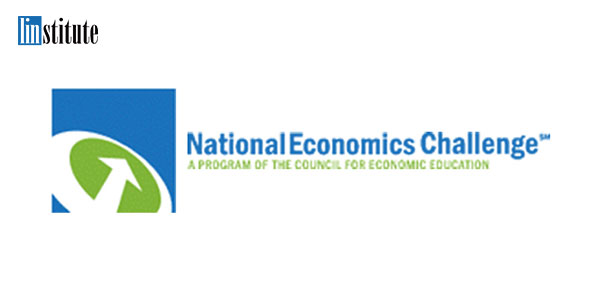- 翰林提供學術活動、國際課程、科研項目一站式留學背景提升服務!
- 400 888 0080
Product Details

一、賽事介紹
全美經(jīng)濟學挑戰(zhàn)賽 (National Economics Challenge) 是美國最具影響力的高中生經(jīng)濟學學術活動,由美國經(jīng)濟教育學會 (Council for Economic Education) 舉辦,旨在激發(fā)學生對經(jīng)濟學知識的興趣,培養(yǎng)解決問題的能力,建立批判性思維習慣。
全美經(jīng)濟學挑戰(zhàn)賽需要組隊參加,每支隊伍必須由4名學生組成,每所學校參賽隊伍數(shù)量不限。比賽分為三個組別,具體分組標準如下:
1. 高級組別 (AS, Adam Smith Division):不設報名門檻。
2. 初級組別 (DR, David Ricardo Division)
參與條件:在 2022年 6月之前,僅學習過 IBDP、AP、AS課程體系中微觀、宏觀經(jīng)濟學其中一門課程
3.Pre組別 (pre Division)
參與條件:在 2022年 6 月之前,從未學習過經(jīng)濟學課程或者僅學過 IGCSE入門經(jīng)濟學其中一門課程
2. 區(qū)域站計分規(guī)則
【個人總分計算方式】
1)Pre Division(入門組別)
- 區(qū)域站中該組別共計 36 道題,包括微觀經(jīng)濟學 24 題,宏觀經(jīng)濟學 12 題。回答正確得 10 分;回答錯誤或者不回答,不得分也不扣分,共計總分 360 分。
2)DR Division(初級組別) & AS Division(高級組別)
- 區(qū)域站中 DR 組別和 AS 組別共計 48 道選擇題,包括微觀經(jīng)濟學 24 題,宏觀經(jīng)濟學 12 題,國際經(jīng)濟和時事 12 題。回答正確得 10 分;回答錯誤或者不回答,不得分也不扣分,共計總分 480 分。
【團隊總分計算方式】
1)Pre Division(入門組別)
- 先取單科團隊內得分最高的兩名同學的分數(shù)加總,計算出單科團隊分數(shù),以此方式分別計算兩個科目,加總后為區(qū)域團隊總分,滿分 720 分。
2)DR Division(初級組別) & AS Division(高級組別)
- 先取單科團隊內得分最高的三名同學的分數(shù)加總,計算出單科團隊分數(shù),以此方式分別計算三個科目,加總后為區(qū)域團隊總分,滿分 1440 分。
2022 的賽事,9月-12月開放報名
1. NEC中國區(qū)域站(中國初賽)
2022-12-1或者2022-12-19
具體比賽環(huán)節(jié):Qualifying Test
2. NEC中國站(中國總決賽)
2022-03,具體比賽環(huán)節(jié):
(1)Qualifying Test
(2)Critical Thinking
(3)Super ECON
(4)Quiz Bowl
3. NEC美國(美國總決賽)
2022-05至2022-06具體比賽環(huán)節(jié):
(1)Qualifying Test
(2)Critical Thinking
(3)Quiz Bowl
三、課程形式
適應對象:
(1)適合9-12年級學生,對經(jīng)濟/商科感興趣的同學
(2)同樣適用于IEO/NEC備賽
(3)全程班課使適用于IB/AP/A-Level預學及考試梳理
四、參賽收獲
1、高效備賽,助力名校申請:
NEC受到美國學術界、金融界及商業(yè)界的廣泛認可,學術活動的獲獎成績和參賽經(jīng)歷可以成為學生申請名校的重大加持。每年約有10,500 名高中學生參加比賽,超過20%的NEC? Finals總決賽選手被Harvard哈佛、Yale耶魯 和Stanford斯坦福等超一流名校錄取。n"]]">NEC受到美國學術界、金融界及商業(yè)界的廣泛認可,學術活動的獲獎成績和參賽經(jīng)歷可以成為學生申請名校的重大加持。每年約有10,500 名高中學生參加比賽,超過20%的NEC ?Finals總決賽選手被Harvard哈佛、Yale耶魯 和Stanford斯坦福等超一流名校錄取。NEC全程班課覆蓋了IB/AP/A-Level這些考試的考察知識點,可以幫助學生一箭雙雕;商學院的教學模式下,完成經(jīng)濟學、金融學、風險管理、分散投資、公司財務和戰(zhàn)略分析、行業(yè)基本面分析等模塊的學習。
2、經(jīng)濟視角洞察世界,提升個人財商素養(yǎng):
經(jīng)濟視角洞察世界,提升個人財商素養(yǎng):NEC需要學生具備優(yōu)秀的經(jīng)濟學知識儲備。在備賽中,通過個性化的課程設置和資深導師的深入指導,學生可以迅速積累經(jīng)濟方面的專業(yè)知識,以經(jīng)濟學視角洞察各個行業(yè)實質,提高解決經(jīng)濟學問題的能力;NEC需要學生具備優(yōu)秀的經(jīng)濟學知識儲備。在備賽中,通過個性化的課程設置和資深導師的深入指導,學生可以迅速積累經(jīng)濟方面的專業(yè)知識,以經(jīng)濟學視角洞察各個行業(yè)實質,提高解決經(jīng)濟學問題的能力;
3、CNBC全球直播,自信邁向國際舞臺:
有方NEC學術活動指導課程覆蓋了這些考試的考察知識點,可以幫助學生一箭雙雕,同時準備NEC學術活動和學生希望參加的 SAT 2, IB, A-Level等學術考試;比賽現(xiàn)場將由美國最知名的三大電視網(wǎng)之一的全球性財經(jīng)新聞臺(CNBC)進行直播。晚間商業(yè)報告(Nightly Business Report)和財經(jīng)論壇(Squawk Box)將進行賽事的后續(xù)報道。
4、中美學生團隊競技,體驗國際學術氛圍:
晉級美國賽的國內學生將和來自美國高中的優(yōu)秀學生共同競爭和合作,充分發(fā)揮各自的優(yōu)勢,取長補短,在跨文化的交流和學習中各自成長,一起針對熱點的財經(jīng)問題進行信息收集、數(shù)據(jù)分析、策略討論和案例展示等全方位的準備工作,并最終進行聯(lián)合答辯收獲成果。
5、結識志同道合的優(yōu)秀同齡人,累積金融圈的初始人脈。
五、課程大綱
課程目標: ?
- 按NEC大綱全面講解重要的經(jīng)濟學知識點和詞匯
- 針對NEC區(qū)預賽選進行針對性備賽
- 學員通過2021年NEC初賽篩選,進入中國區(qū)決賽
【第一階段:講解微觀經(jīng)濟學知識】
- 學習內容:學習消費者行為、生產者行為、商品和服務市場、生產要素市場、效率、市場失靈、政府作用相關知識。
- 本階段結束時,要求學生能充分儲備區(qū)域賽所需的微觀經(jīng)濟學知識。
【第二階段:講解宏觀經(jīng)濟學知識】
- 學習內容:總供給和總需求、衡量國民收入、技術和經(jīng)濟增長、通貨膨脹、經(jīng)濟周期、失業(yè)、開放、宏觀經(jīng)濟政策相關知識。
- 本階段結束時,要求學生能充分儲備區(qū)域賽所需的宏觀經(jīng)濟學知識。
?
【第三階段:儲備國際經(jīng)濟學知識】
- 學習內容:學習外匯、國際收支平衡、對外貿易、發(fā)展經(jīng)濟學等相關話題
- 本階段結束時,要求學生能充分儲備區(qū)域賽所需的國際經(jīng)濟學知識。
Part 1 - Microeconomics
1.Cost and Production
(1.1)Costs and Revenues(Production, Economies of Scale)
(1.2) Marginal Cost and Marginal Return
2. Market Mechanism
(2.1) Demand and Supply Analysis(Marginal Utility, Dead-weight-loss)
(2.2)Elasticity
(2.3)The Price Mechanism
3. Market Competition and Market Failure
(3.1 )Perfect Competitive Market
(3.2) Monopolistic Competition and Contestable Markets
(3.3) Monopoly, Oligopoly and Monopsony
(3.4) Market Failure
4. Government Intervention
(4.1)Regulation and Competition Policy (Indirect Taxes, Subsidies, State Provision, Price Controls and Buffer Stocks, Extending Property Rights, Tradable Pollution Permits)
(4.2) Government Failure (Externalities, Merit and Demerit Goods, Public goods, Imperfect Information, Immobility of Resources, Unstable Commodity Prices, Lack of Equity)
(4.3) Privatization, Deregulation and Internal Markets
5. The Labor Market
(5.1) Wages (the National Minimum Wage, Wage Determination)
(5.2) Trade Unions and Monopsony Employers
(5.3) Income Inequality
Part 2 - Macroeconomics
6. Macroeconomic Models
(6.1) Macroeconomic Indicators and the Circular Flow of Income (GDP, Consumption, Saving and Investment, Living Standards, Development and Sustainability)
(6.2) Aggregate Demand, Aggregate Supply and Equilibrium (Long-run and Short-run, Keynesianism)
7. Macroeconomic Performance
(7.1) Economic Growth and the Business Cycle
(7.2) Inflation and Deflation
(7.3) Unemployment (The Phillips Curve)
8. Financial Sector and Monetary Systems
(8.1) Money Market and Interest Rate
(8.2) Money Supply and Central Banks
(8.3) IS-LM Model
9. Policy Tools
(9.1) Fiscal and Monetary Policies
(9.2) Supply-Side Policies
10. International Economics
(10.1) The Balance of Payments
(10.2) Exchange Rates and Foreign Exchange Market
(10.3) International Trade and International Competitiveness
(10.4) Promoting Growth and Development
快速搜索
? 2025. All Rights Reserved. 滬ICP備2023009024號-1








